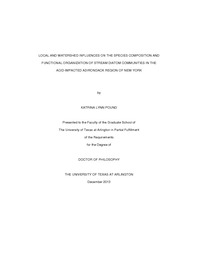| dc.description.abstract | For over 40 years, acid deposition has been recognized as a serious international environmental problem, but efforts to restore acidified streams and biota have had limited success. The need to better understand the effects of different sources of acidity on streams has become more pressing with the recent increases in surface water organic acids, or `brownification', associated with climate change and decreased acid deposition. This dissertation is a large scale multi-seasonal investigation of stream diatom communities in the Adirondack region of New York, one of the most acid-impacted regions in the United States. My first objective is to explore the pathways of wetland control on stream organic matter concentrations, aluminum chemistry, and diatom taxonomic and functional composition. I demonstrate that streams with larger watershed wetlands have higher organic content, lower concentrations of acidic anions, and lower ratios of inorganic to organic aluminum, all beneficial for diatom biodiversity and guilds producing high biomass. For my second objective, I examine species turnover, or beta diversity, of the overall diatom community and individual functional guilds during periods of low acidity, high organic acidity, and high inorganic acidity in streams. My results indicate that while both sources of acidity reduce beta diversity, the reduction in beta diversity is more severe when the source of acidity is inorganic. I also find significant differences in species turnover across guilds, with small-bodied, tolerant species exhibiting lower beta diversity than larger-bodied, less tolerant species. For my third objective, I examine the roles of deterministic versus stochastic processes in shaping stream diatom communities across periods varying in source and extent of acidity. I find that the role of stochastic processes is reduced during periods of high relative to low acidity. Overall, my results indicate that diatom communities in this region are more structured by environmental rather than spatial factors. | en_US |

